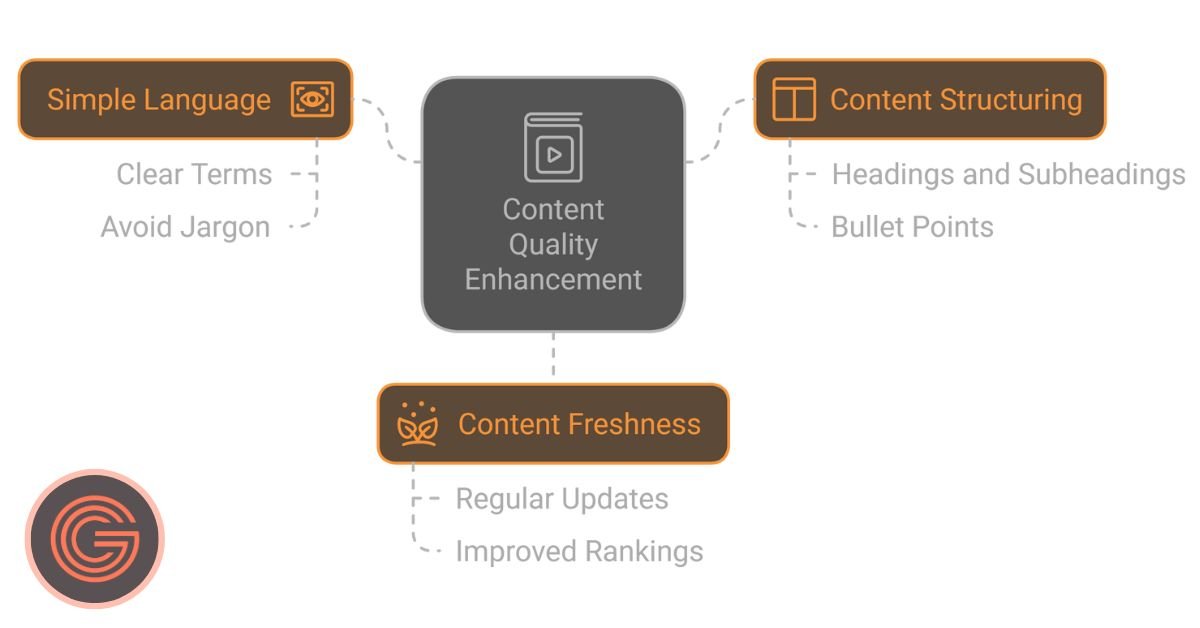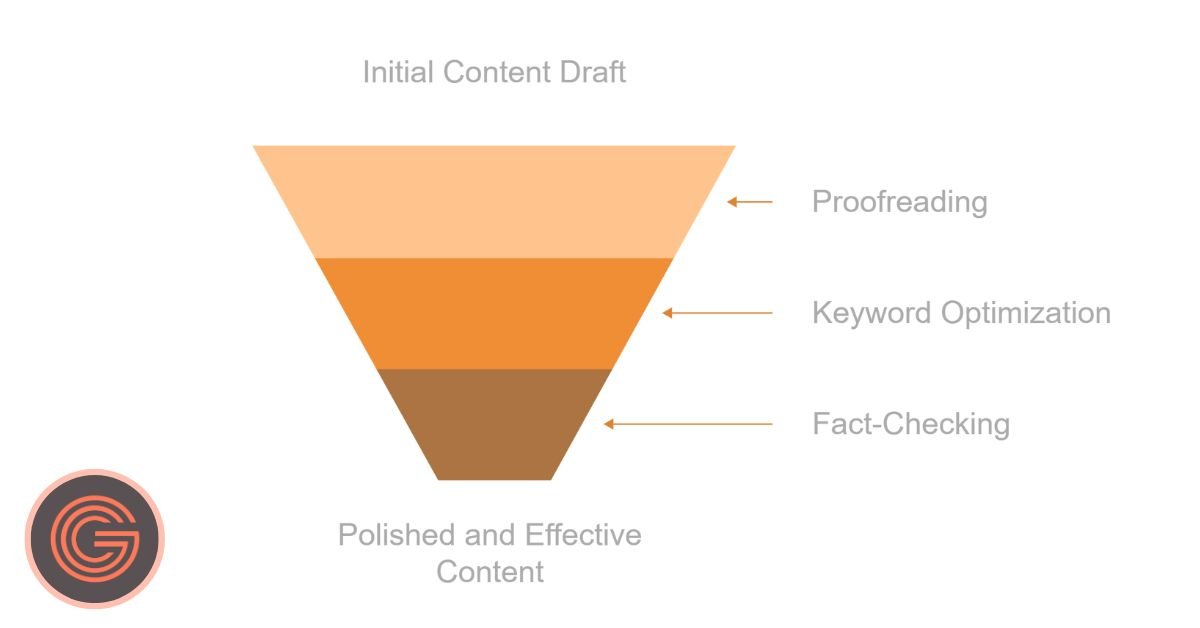
How to Write Content for Google to Improve SEO Performance
Google has repeatedly emphasized that writing for users, not algorithms, is the foundation of effective content. As John Mueller, Google’s Search Advocate, stated, “Write for your audience, and the rest will follow.” This principle highlights why efforts to write content for Google must center on addressing user needs. By creating content that resonates with readers, you can ensure it performs well in search.
By focusing on meaningful engagement and aligning with search intent, your content attracts traffic and builds credibility and authority. And by understanding how search engines work, you can tailor your material to satisfy algorithms while keeping readers engaged. Writing with this dual focus ensures your content stands out in a crowded digital market and achieves measurable impact.
Do you want to know how to write content for Google that truly ranks? It starts with identifying user needs, structuring content logically, building topical authority and relevance, and incorporating the most relevant keywords. At GLP Marketing, we help businesses create content that ranks higher and connects with their audience to build visibility and trust. Our local SEO services deliver real results. Ready to boost your rankings? Contact our team and start optimizing your content strategy today.
Our guide will show you how to create content that aligns with Google’s algorithms and satisfies user intent. Whether you want to stand out locally or climb the search rankings, these proven strategies will help you create content that genuinely connects and drives results.
Why Should You Write Content for Google?

Writing content for Google combines the art of engaging readers with the science of search engine optimization (SEO). It’s about crafting quality content that ranks well in search engine rankings, drives traffic, and delivers value. Here’s why it matters:
Enhances Brand Awareness
Content optimized for Google improves visibility and helps you reach a broader audience. For example, an engaging blog post targeting popular search queries can help establish authority in your niche.
Improves Search Engine Visibility
High-quality content aligns with search engine algorithms and helps your pages rank higher on search engine results pages (SERPs).
Attracts New Leads
Keyword-rich, well-structured content draws potential customers actively searching for solutions. With compelling headlines and informative copy, you can keep visitors engaged longer and boost the likelihood of conversions.
Generates Credibility and Trust
Accurate, thoughtfully researched content forms trust with your audience by demonstrating credibility and attention to detail. Citing authoritative sources and offering valuable insights establishes a writer and you as a trusted authority.
Boosts Conversion Rates
Writing content tailored to user intent engages readers and drives actions like purchases or sign-ups. A strong call-to-action paired with relevant information can significantly improve your bottom line.
Builds Long-Term Traffic
Consistently publishing great content establishes authority and sustains traffic growth over time. Sharing evergreen content further amplifies its impact.
Cost-Effective Marketing Strategy
Unlike paid ads, SEO-optimized content delivers long-term value without recurring costs. A single article that ranks highly on a search engine results page can generate traffic and leads for months or years.
It’s nearly impossible to envision a thriving business without a strong online presence. A well-crafted digital footprint ensures your brand remains visible, accessible, and relevant in a competitive market.
How to Write Content for Google in 8 Steps
A structured process or framework is fundamental for consistently generating Google-friendly content. Consider creating a standard operating procedure (SOP) that a writer can easily follow to consistently deliver content that meets user needs and SEO best practices for each post. Here’s how:
1. Understand Your Audience and Goals
Effective content starts with knowing your audience and objectives. Research and find keywords your audience uses and how your writing addresses those needs. Here’s how to get started:
Identify Audience Needs – Pinpoint challenges your audience faces and provide solutions. Addressing these pain points ensures your content is valuable and resonates with readers.
Use Data-Driven Insights – Leverage tools like Google Analytics to analyze search terms and user behavior. These insights help you tailor content that’s centered around a main keyword, aligns with user intent, and improves performance.
Develop a Content Strategy – Align your strategy with audience preferences to maximize impact. A well-structured strategy often produces more tangible results.
To create impactful content, a writer should understand its purpose and the goals it should achieve. Consider your audience’s demographics and needs, then craft material that speaks directly to their challenges and interests. Using tools like SemRush, Ahrefs, or Google Trends can help you discover relevant keywords, track search trends, and reverse engineer competitor content strategies.
Finally, develop a comprehensive strategy that aligns your content goals with audience needs. Whether you aim to drive traffic, generate leads, or build authority, a content roadmap helps you drive consistent results and sustainable growth in the long run.
2. Adhere to Google’s Content Guidelines
Google prioritizes content that’s helpful, relevant, and authoritative. Adhering to its guidelines ensures your content aligns with what search engines and users value most. Why is this important? Because it enhances your visibility and builds long-term trust with your audience and Google.
Standardize quality over quantity. Deliver content that meets user expectations and search intent. Quality content answers key questions, solves problems, and keeps readers engaged. This matters because it signals to Google that your post is valuable and worth ranking higher.
Furthermore, brainstorm ideas and create deliverables that align with Google’s emphasis on audience-centered content. The Helpful Content Update rewards sites that prioritize user experience and penalizes those that use shallow and duplicate material.
Adhering to Google’s Helpful Content Update is crucial for SEO success. By creating material that prioritizes relevance, originality, and depth, you can expect your content to satisfy user needs better while aligning with search expectations. For instance, answering frequently asked questions or providing insights tailored to your audience can significantly boost engagement and rankings.
3. Research and Prepare for Your Content
Preparation is key to crafting an impactful article. Taking time to plan and strategize ensures your material aligns with audience needs and search engine expectations. This groundwork sets the stage for content that performs well. Concentrate on the following:
Most Important – User Intent
Understanding user intent is the foundation of effective content creation. Recognizing what searchers seek and aligning your material with those needs strengthens your relevance and drives engagement. Let’s take a deeper look:
- Understanding Keyword and Search Intents – Each type of user intent serves a unique purpose. Informational intent targets users seeking knowledge, navigational intent guides users to specific solutions, and transactional intent centers around users ready to take action. Commercial intent, on the other hand, focuses on users comparing options or evaluating products before making a decision, such as researching “best personal injury lawyers in Chicago.”
- Aligning Content Goals with User Queries – Keeping content aligned with search intent improves user satisfaction and increases your chances of ranking higher in Google or Bing. For instance, a writer can tie in People Also Ask questions to boost a blog’s relevance and engagement.
Keyword Research
Keyword research identifies the terms your audience is searching for and helps a writer craft content that targets those queries effectively. By understanding your audience’s language, you can align your site with their expectations. This step bridges the gap between your writing and user intent and helps you drive traffic to your site. To maximize its impact, learn to master tools for keyword research and how to identify primary and secondary keywords. Use tools like Google Keyword Planner or Ahrefs to discover keywords that align with your audience’s interests. Prioritize search volume, relevance, and competition to choose keywords that offer the best opportunities. Use SemRush, Moz, or Google Trends to identify trending keywords and analyze performance. These tools help a writer learn about their audience’s search habits and craft a post that meets their needs while capturing their attention.
Analyze Your Competitors
Analyzing competitors’ strategies offers a valuable blueprint for success while highlighting gaps where your content can stand out. By understanding the intent behind their content, you can refine your approach and deliver material that resonates deeply with your audience. Here’s how to align content with different search intents:
- Informational Intent – Aims is to deliver the most relevant and valuable insights. For example, a writer can craft a detailed blog post that answers “How to file an insurance claim after an accident.” This establishes site authority and attracts high-intent traffic seeking expert guidance.
- Navigational Intent – Guides users to specific solutions by helping them locate the exact page or service they need. For example, a user searching for “Rockpoint personal injury services” can be directed to a dedicated service page. This makes it easy for them to find the information they need.
- Transactional Intent – Targets users who are ready to take action, such as making a purchase or signing up for a service. For example, a well-crafted landing page offering a free legal consultation with a prominent “Schedule Now” button can effectively drive immediate conversions and generate valuable leads.
- Commercial Intent – Target users who are comparing products or services and are close to making a purchasing decision. Content like comparison guides, product reviews, or case studies helps influence their choice. For example, a blog post comparing top software solutions in your industry can position your offering as the best option, driving informed decisions and conversions.
Effective queries bridge the gap between user searches and your content. Prioritize identifying gaps and opportunities by analyzing top-performing competitor content. This approach helps uncover areas where your content can stand out:
Identify Primary and Secondary Keywords
Tools like Ahrefs and SemRush provide insights into competitor strategies and keyword performance. Use these insights to refine your approach. For instance, targeting less competitive but highly relevant keywords can give you an edge.
Analyze Competitor Strategies
Study top-ranking web URLs to uncover what makes them successful. Look for gaps or opportunities to create unique, impactful content. For example, addressing unanswered questions or offering deeper insights can set your words apart.
By thoroughly preparing and researching, your writing can drive better engagement and rankings.
4. Create Valuable and Relevant Content for Humans

For a writer, connecting with readers is key to building trust, driving engagement, and achieving impactful results. High-quality, engaging, and informative content holds readers’ attention and motivates them to take action. Here’s what every writer should keep in mind to create content that resonates and drives results:
- Use Simple Language – Write in clear, concise terms that people understand. Avoid jargon unless it’s necessary and relevant to your audience. Simplicity ensures accessibility, broadening your content’s appeal and fostering trust.
- Break Up Content – Every article and page should use headings, subheadings, and bullet points for better readability. Breaking up long blocks of text makes it easier for readers to digest information and improves user experience. Lastly, make sure your copy aligns with your page title.
- Keep It Fresh – Regularly update content to maintain relevance and accuracy. Fresh content signals to both users and search engines that your material is current and valuable, which can improve rankings.
To keep readers engaged, use techniques like storytelling, relatable examples, and compelling visuals. Incorporate real-world scenarios or case studies to illustrate key points and enhance understanding with striking imagery or infographics. These elements create a dynamic experience and ultimately help a writer craft compelling content.
5. Build Trust and Authority with Links
Earning trust and authority is key to effective content strategy, and links play a vital role in achieving this. Here’s how to incorporate internal and external links strategically across your websites:
- Internal Links – Connect to other relevant web pages on your site to enhance user experience and improve SEO. For example, linking to related blog posts or product pages encourages readers to explore more of your content.
- External Links – Reference credible sources to support your claims and provide additional context within the post. This adds depth to your article and also strengthens trust with readers by showing you rely on authoritative information.
- Anchor Text – Use descriptive and relevant anchor text for your links. This helps users understand where the link will take them and provides Google and other sites with more context about your writing.
To find and use effective external links, prioritize reputable sources such as industry leaders, academic publications, or high-ranking websites. Tools like Ahrefs, Moz, or SemRush can help identify quality backlinks and analyze link-building opportunities. Avoid linking to low-quality or untrustworthy sites, as this can harm your credibility.
6. Don’t Forget to Optimize for SEO
Crafting engaging content is important, but it must be optimized for SEO to reach its full potential. Google prioritizes content that is not only valuable to users but also well-structured for search engines. Without proper optimization, even the most engaging material might go unnoticed.
On-Page Optimization
Optimizing your on-page writing helps search engines easily understand its relevance and value. This process improves your chances of ranking higher in search results while keeping users engaged. To achieve this, prioritize the following:
Keyword Placement – Use targeted keywords in titles, headers, introductions, and conclusions. This helps search engines grasp your content’s intent and boosts visibility in relevant search terms.
Semantic SEO – Incorporate synonyms and related terms naturally throughout your writing to enhance its relevance and context. This helps your content appeal to evolving searches.
Header Tags – Structure your content with H1, H2, and H3 tags to improve readability and highlight key sections. Well-organized headers guide readers through your material and make it easier for search engines to categorize your title headers chronologically.
Meta Descriptions – Write descriptive and keyword-rich meta descriptions to improve click-through rates from SERPs. Engaging meta descriptions attract users and increase traffic to your site while your on-page words and resources keep them longer.
Image Optimization
Optimizing images enhances accessibility, improves loading speed, and enhances the overall user experience and performance. To achieve effective optimization, you need to implement alt text and compression. Adding image alt text with relevant search words improves accessibility and visibility. Alt text ensures your images contribute to SEO while supporting visually impaired users. When it comes to compression, optimizing images enhances your content’s accessibility and loading speed, directly improving the user experience and overall performance.
Technical Aspects
Technical optimization ensures your website performs well and provides a seamless experience for users. Strengthening these elements is crucial for visibility in Google rankings:
Mobile Responsiveness – Ensure your website is fully responsive and provides a seamless experience on all devices. With the majority of users browsing on mobile, this step is essential for retaining visitors.
Page Load Speed – Optimize your site’s loading time to enhance user experience and reduce bounce rates. Faster sites keep users engaged and improve rankings.
Descriptive URLs – Use clear and concise URLs that describe the page content and include keywords. Well-structured URLs improve navigation and signal relevance to search engines.
Title Tags – Craft catchy, keyword-optimized title tags that attract clicks and accurately represent the content. Strong title tags improve visibility and encourage user engagement.
By prioritizing these key areas, a writer can captivate readers and achieve strong search engine performance. In short, effective SEO bridges the gap between quality content and discoverability.
7. Review and Edit

Careful review and thorough editing are essential to crafting polished, professional content that resonates with your audience. This step helps your writing be error-free and optimized to meet your goals. By dedicating time to this process, you can elevate the quality and effectiveness of your other pages. Here’s how:
- Proofreading for Grammar and Clarity – Tools like Grammarly and Hemingway Editor can help identify and correct errors, improve sentence structure, and enhance readability. Clear, error-free writing builds credibility and ensures your title and post are easily understood.
- Ensuring Keyword Density – Strike a balance by avoiding keyword overuse while keeping your content natural. Maintaining appropriate keyword density improves SEO without compromising the flow and readability of your post.
- Fact-Checking and Updating – Verify all data and statistics to maintain accuracy and authority. Regularly updating content on your domain keeps it relevant and ensures it continues to meet the needs of your audience. This also helps websites sustain performance over time.
8. Measure Success Through Multiple KPIs
Key Performance Indicators (KPIs) are measurable metrics that gauge the success of your content strategy. They provide critical insights into what’s working and where improvements are needed, enabling data-driven decisions. By tracking KPIs, you ensure your efforts align with business objectives and audience expectations.
Platforms like Google Analytics and Search Console help monitor content performance. For example, Google Analytics provides insights into user behavior, while Search Console identifies which queries are driving traffic. Leveraging these tools helps refine strategies and prioritize efforts in areas with the highest impact.
You should monitor organic traffic, bounce rate, time on page, and keyword rankings. For instance, an article with a low bounce rate and extended time on the page indicates engaging content, while improved keyword rankings show better search visibility. Tracking these metrics ensures your writing meets both user and search engine standards.
Use data insights to adjust your content strategy for better results. If an article shows high traffic but low conversions, have a writer refine the call-to-action or enhance the content’s relevance. Regular iteration based on performance data helps maintain growth, backlinks, and engagement.
Other sources and tools, such as UTM parameters and conversion tracking in Google Analytics, can be used to track leads from Google search results. These methods provide detailed reports on where traffic originates and how users interact with a post and websites. By focusing on KPIs, you can continuously improve your content strategy and achieve measurable success.
Mistakes That Can Lower Your Google Visibility
Avoiding common SEO mistakes is crucial for maintaining strong Internet rankings and ensuring your content resonates with both users and search engines. Even small errors can significantly impact your visibility and traffic. To keep your rankings intact the easy way, steer clear of these pitfalls:
| Mistakes | Why It Matters | Example |
| Not Optimizing for Mobile | Poor responsiveness can drive users away. | A site that doesn’t load well on phones. |
| Lack of Clear CTAs | Users need direction to take action. | Pages without “Contact Us” buttons. |
| Duplicate Content Issues | Google penalizes repetitive pages. | Two blogs with identical content. |
| Over-Character Meta Content | This leads to truncation in search results. | Titles exceeding 60 characters and meta descriptions exceeding 155. |
| Failing to Update Content | Outdated information reduces relevance. | Not updating blogs or pages for several months to years. |
| Misusing Headers | Poor structure confuses readers and crawlers. | Missing H2s or H3s. |
By addressing these mistakes, a writer can make sure his content remains effective, relevant, and optimized for both user engagement and search engine rankings.
How Long Does It Take To See Results in Search Rankings?

Achieving higher rankings in Google search results requires time, typically ranging from 3-6 months. Success depends on factors such as competition, content quality, and consistency. With persistence and routine updates, you can foster sustained growth in Internet traffic and visibility.
Want to Rank Higher on Google Search?
Crafting Google-friendly content is essential for short and long-term success. By combining expertise, relevance, and user-centered strategies, you can cultivate trust, boost authority, and achieve results that would otherwise take years to achieve. This blog has outlined the essential steps to optimize your domain, from understanding your audience to avoiding common SEO pitfalls.
To stay competitive, a writer must adapt to Google’s ever-evolving algorithm updates and continue refining their content strategy. Resources like Google Analytics, Search Console, and professional SEO services provide the insights and support needed to drive success. Without a well-structured approach, the visibility and engagement of your words may fall short.
Ready to elevate your site rankings and reach your audience more effectively? At GLP Marketing, we specialize in crafting tailored SEO strategies that deliver real results. Explore our SEO services or contact us to get started today.
Every successful SEO launch begins with valuable, optimized content. What’s your strategy missing?
SEO Marketing Agency
Our mission at GLP is to propel businesses to new heights with the highest level of SEO services